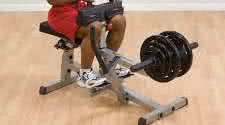Weight Training Exercise Essentials: Seated Calf Raises

Proper Exercise Descriptions in Detail
Performance
Sit with the pads over your lower thighs. Position the balls of your feet on the edge of the foot platform. Keep your knees flexed at a constant angle to hit the soleus. Look straight ahead, contract your abdominals, flatten your back and slowly stretch completely. Pause and then slowly contract fully. Exhale as you raise the weight and inhale as you lower it.Warmup
Use a controlled general and specific warmup for both the soleus and gastrocnemius before you do seated calf raises. You can easily aggravate problems with your Achilles tendons and tibialis posterior muscles by doing calf raises, especially if you also do long-distance walking or jogging.Do's and Don'ts
» Do keep your toes pointing straight ahead.» Do move the weight smoothly and deliberately through the entire range of motion.
» Do pause for a full two seconds at both the top and bottom of the movement.
» Don't perform this exercise if you have Achilles tendonitis, shin splints or sore arches.
» Don't use excessive weight.
» Don't let your range of motion be limited by the height of the platform or support board.
Kinesiological Analysis
To do seated calf raises, you must first adjust the position of the thigh pads to fit the length of your legs. Most newer models can be adjusted easily by placing a standard weight key through a bore on a sliding metal sleeve attachment. The pads should be as close to the floor as possible so that you can stretch fully at the bottom of the movement. Point your toes while you push the weight support bar forward. Then sit up straight focus your eyes ahead, contract your abdominals and lightly grasp the outside of the pads.Stretch fully at the bottom of the movement, pause, then point your toes so that you contract your calf muscles powerfully. To maximize tension on the soleus, exaggerate the stretch and avoid bounding or leaning backward. Remember, the knee joint is flexed at about 90 degrees to start the exercise. The limiting factor in how far to lower the load should be your flexibility, not the mechanical stop on the machine. The foot position doesn't affect soleus use. All toe positions have the same effect on the soleus.